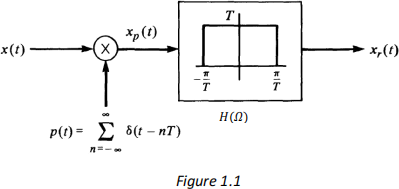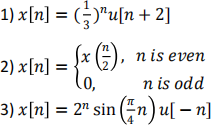CAN207 Continuous and Discrete Time Signals and Systems Assignment 2
Hello, dear friend, you can consult us at any time if you have any questions, add WeChat: daixieit
CAN207
Continuous and Discrete Time Signals and Systems
Assignment 2: DT Signals and Systems
Deadline: Dec. 11 th , 23:59.
Submission: Submit the electronic version to Learning Mall.
Information: This assignment takes 15% in the total mark.
Question 1 (20 marks)
A) Consider impulse train-sampling of a continuous-time signal x(t):
x(t) = cos (2πt) + 2 cos 3?? cos 6??
Assume sampling rate is 5 Hz.
1) sketch the spectrum of x(t), and spectrum of the resulted weighted impulse train xp(t).
2) The frequency which, under the sampling theorem, must be exceeded by the sampling frequency is called the Nyquist rate. Find the Nyquist rate of x(t) in Hz.
3) Assume the resulted discrete-time sequence is x[n]. Sketch the DTFT of Hz.
B) Consider the system in Figure 1.1. x(t) is sampled with a periodic impulse train, and a reconstructed signal xr(t) is obtained from the samples by lowpass filtering. The sampling period T = 1ms, and x(t) is a sinusoidal signal of the form x(t) = cos (2πf0t + θ).

For each of the following choices of f0 and θ, determine xr(t).
1) f0 = 250 Hz, θ = π/4
2) f0 = 750 Hz, θ = π/2
Question 2 (20 marks)
Consider the system shown in Figure 2.1, where ?(?) is a lowpass filter with cutoff frequency at 0.2?. The spectrum of ?[?] is given in Figure 2.2. Assume the frequency response of the overall system is ? ? .

1) Sketch the spectrum of ?1 [?], ?2 [?], ?3 ? , ?4 [?] respectively;
2) Obtain magnitude plot of ? ? . Is this system a lowpass, highpass, bandpass or bandstop system? Sketch the spectrum of ? ? .
3) Now consider replacing ?(?) by a highpass filter with cutoff frequency at 0.2?. Sketch the spectrum of ? ? .
Question 3 (15 marks)
Consider a system consisting of the cascade of two LTI systems with frequency response

and

1) Find the difference equation describing the overall system;
2) Determine the impulse response of the overall system;
3) Use adders, multipliers, and delay units to draw the block-diagrams of ?(? ??) in Direct form I, Direct form II, cascaded form and parallel forms.
Question 4 (10 marks)
A) Determine the DTFT of each of the following sequences:

B) Determine the signal corresponding to each of the following transforms:

Question 5 (20 marks)
A) Two sequences:

1) Calculate the linear convolution ? ? ∗ ℎ[?];
2) Calculate the circular convolution ? ? ⊛ ℎ ?
B) With the knowledge of DFT values at even indices of a 7-point real sequence:
X(0) = 3.6; X(2) = 2.8+j2.5; X(4) = 2.1+j4.2; X(6) = 6.2+j4.7;
Find the DFT values at odd indices.
Question 6 (15marks)
Consider an LTI system described by the following LCCDE:

The system may or may not be causal or stable.
1) Obtain the transfer function of the system ?(?);
2) By considering the pole-zero plot, determine all possible conditions of ROC?, and discuss the causality and stability of system for each case;
3) By considering the pole-zero plot, roughly sketch the magnitude spectrum of ?(? ??).
2023-12-09
DT Signals and Systems